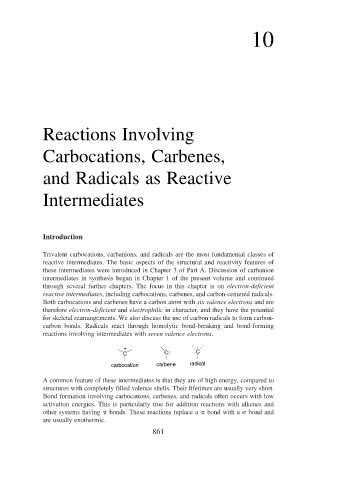Page 885 - Advanced Organic Chemistry Part B - Reactions & Synthesis
P. 885
10
Reactions Involving
Carbocations, Carbenes,
and Radicals as Reactive
Intermediates
Introduction
Trivalent carbocations, carbanions, and radicals are the most fundamental classes of
reactive intermediates. The basic aspects of the structural and reactivity features of
these intermediates were introduced in Chapter 3 of Part A. Discussion of carbanion
intermediates in synthesis began in Chapter 1 of the present volume and continued
through several further chapters. The focus in this chapter is on electron-deficient
reactive intermediates, including carbocations, carbenes, and carbon-centered radicals.
Both carbocations and carbenes have a carbon atom with six valence electrons and are
therefore electron-deficient and electrophilic in character, and they have the potential
for skeletal rearrangements. We also discuss the use of carbon radicals to form carbon-
carbon bonds. Radicals react through homolytic bond-breaking and bond-forming
reactions involving intermediates with seven valence electrons.
+ .
C C: C
carbocation carbene radical
A common feature of these intermediates is that they are of high energy, compared to
structures with completely filled valence shells. Their lifetimes are usually very short.
Bond formation involving carbocations, carbenes, and radicals often occurs with low
activation energies. This is particularly true for addition reactions with alkenes and
other systems having bonds. These reactions replace a bond with a bond and
are usually exothermic.
861

